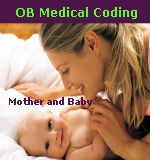Alicia: Q: She had a question about these codes 655 and 656, fetal conditions affecting the mother’s care. Her basic question here is: When do you separate the charts? When do you have a baby chart and a mother chart? It gets very confusing because of the wording, the terminology of the conditions because it will have the mother mentioned and the baby and the fetus, and all this stuff is listed in the description of the code. But this is what you need to know. And look, didn’t I find a precious picture?
Laureen: Yes.
Alicia: A: The best way to remember this is when before the baby is born, you’re technically one person. So, the mother and the baby’s chart are never separated until the baby comes out. Once the baby comes out, then it’s two charts. Once delivery has happened – and what is that? Like, the fourth stage of labor or fourth stage…is actual delivery. After that stage, you have two charts.
OB Medical Coding: Mother and Baby — Video

The wording can get very complicated. Whenever the mother comes in even it’s the day she is delivering, then the mother whatever the complications even the fetus is having – and that can be fetal stress, the mother can have hypertension, but the baby can be under fetal stress, that’s all going to go in the mother’s chart because the baby has not delivered. So, any complications of the fetus before the baby is born goes into the mother’s chart and it usually say “complication” and then it will tell you what type of a complication it is, and there can be all kinds of them.
Things that you’ll see once the baby is delivered, that last stage of labor has happened, you’ve got a baby chart, then you’re going to see complications like: aspiration, meconium – someone is going to correct me on that – but if a baby in utero has had a bowel movement, then they have that green stuff and they can aspirate that and they can get an infection. It’s very treatable. That’s one thing that they always ask mothers about.
Low birth weight – they can check the size of the baby before it’s born and they will comment on that and they will code that. It will go on the mother’s chart, but once that baby is born it’s called light for days. This is how it’s looked up; it’s on the baby’s chart. So, just always think in your head not necessarily what the words are telling you but has the baby been delivered? Two charts. That’s what you need to know.
Rosalina posted on there – MAS (meconium aspiration syndrome) and it’s green. And they know right away because as soon as your water breaks, it’s green water instead of clear.
Anyway, that before the baby is born then it’s a complication on the mother’s chart. As soon as that baby comes out, it’s the same thing. It’s a complication to the baby, then it’s separated, two separate codes, two separate charts.
OK. Real quick hopefully for you. You can go into real depth to this and maybe later if somebody has more questions, we can do that at another time.
Laureen: Unless we’re [indiscernible – 1:11:04] they call it mama bills and baby bills.
Alicia: There you go! That’s right. Once you figure out the separation and you get it in your head and it clicks, it’s not complicated. That’s why OB-GYN coders get paid the big bucks because it’s multiple, multiple codes for stuff like this.
![[CCO] Certification Coaching Organization LLC [CCO] Certification Coaching Organization LLC](https://www.cco.us/wp-content/uploads/2015/05/CCO-Logo-2015-d3-500px.png)
